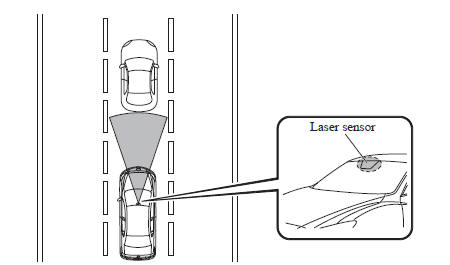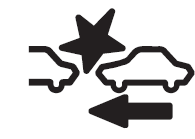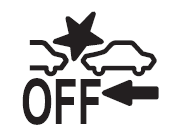Mazda 3 Owners Manual: Smart City Brake Support (SCBS)
The Smart City Brake Support (SCBS) system is designed to reduce damage in the event of a collision by operating the brake control (SCBS brake) when the system's laser sensor (front) detects a vehicle ahead and determines that a collision with a vehicle ahead is unavoidable. It may also be possible to avoid a collision if the relative speed between your vehicle and a vehicle ahead is less than about 15 km/h (9.3 mph).
In addition, when the driver depresses the brake pedal while the system is in the operation range at about 4 to 30 km/h (2 to 18 mph), the brakes are applied firmly and quickly to assist. (Brake Assist (SCBS brake assist))

| WARNING
Do not rely on the Smart City Brake Support System (SCBS) as a
substitute for safer
driving:
The Smart City Brake Support (SCBS) system cannot compensate for unsafe
and reckless
driving, excessive speed, tailgating (following another vehicle too
closely), and driving on
slippery roads such as wet, snowy, and icy roads (reduced tire friction
and road contact
because of water on the road surface). You can still have an accident. Do not rely completely on the Smart City Brake Support (SCBS) system:
Do not modify the suspension: If the vehicle height or inclination is changed, the system will not be able to correctly detect vehicles ahead. This will result in the Smart City Brake Support (SCBS) system not operating normally or mistakenly operating, which could cause a serious accident. Turn off the Smart City Brake Support (SCBS) when the vehicle is running on a chassis roller or being towed: Turn off the Smart City Brake Support (SCBS) system to prevent mistaken operation when the vehicle is running on a chassis roller or being towed. See the next page on how to turn off the Smart City Brake Support (SCBS). Refer to Stopping The Smart City Brake Support (SCBS) System Operation on . |
CAUTION
|
NOTE
- The Smart City Brake Support (SCBS) system will not operate if the driver is deliberately performing driving operations (accelerator pedal and steering wheel).
- The Smart City Brake Support (SCBS) system will operate under the following conditions.
- The engine is running.
- The Smart City Brake Support (SCBS) warning light (amber) does not illuminate.
- The vehicle speed is between about 4 to 30 km/h (2 to 18 mph).
- The Smart City Brake Support (SCBS) system is not turned off.
- The DSC operation is not turned off using the DSC OFF switch.
- The DSC is not malfunctioning.
- The Smart City Brake Support (SCBS) detects a vehicle ahead by emitting a near-infrared laser beam and receiving the beam reflected off the reflector of the vehicle ahead, and then using it for the measurement. Consequently, the Smart City Brake Support (SCBS) may not operate under the following conditions:
- Reflection of the laser is poor due to the shape of the vehicle ahead.
- The vehicle ahead is significantly dirty.
- Under bad weather condition, such as rain, fog and snow.
- The window washer is being used or the windshield wipers are not used when it's raining.
- The windshield is dirty.
- The steering wheel is turned completely left or right, or the vehicle is accelerated rapidly and comes close to the vehicle ahead.
- Trucks with low loading platforms and vehicles with an extremely low or high profile.
- Vehicles with certain shapes such as a vehicle carrier.
- Under the following conditions, the Smart City Brake Support (SCBS) system may not operate normally.
- Heavy luggage is loaded in the luggage compartment or on the rear seat.
- If there is the possibility of partial contact with a vehicle ahead.
- When driving on continuously curving roads, and entering and exiting exits.
- Elongated luggage or cargo is loaded onto installed roof rails and covers the laser sensor (front).
- Exhaust gas from the vehicle in front, sand, snow, and water vapor rising from manholes and grating, and water splashed into the air.
- When towing a malfunctioning vehicle.
- In the following cases, the laser sensor (front) may inadvertently determine that there is a vehicle ahead and the Smart City Brake Support (SCBS) system may operate.
- Objects on the road at the entrance to a curve.
- Vehicles passing in the opposite lane while making a curve.
- Metal objects, bumps, or protruding objects on the road.
- When passing through a toll gate.
- When passing under a vinyl curtain or flag.
- Plastic objects such as pylons.
- Two-wheeled vehicles, pedestrians, animals or standing trees.
- Vehicle is driven with some of the tires having significant wear.
- When the system operates, the user is notified by the flashing Smart City Brake Support (SCBS) indicator light (red) and the active driving display * .
- The Smart City Brake Support (SCBS) warning light (amber) turns on
when the system
has a malfunction.
Refer to Warning Lights on .
Smart City Brake Support (SCBS) Indicator Light (Red)
If the Smart City Brake Support (SCBS) is operating, the indicator light (red) flashes.

Stopping the Smart City Brake Support (SCBS) System Operation
The Smart City Brake Support (SCBS) system can be temporarily deactivated.
Refer to Personalization Features on .
When the Smart City Brake Support (SCBS) system is turned off, the Smart City Brake Support (SCBS) OFF indicator light turns on.

When the engine is restarted, the system becomes operational.
NOTE When the DSC OFF switch is pressed to stop the DSC operation, the Smart City Brake Support (SCBS) system operation also stops and the Smart City Brake Support (SCBS) OFF indicator light turns on.
 Mazda Radar Cruise Control
(MRCC)
Mazda Radar Cruise Control
(MRCC)
The Mazda Radar Cruise Control (MRCC) system is designed to maintain headway
control *1
according to the vehicle speed using a radar sensor (front) to detect the
distance to a vehicle
ahead, and ...
 Forward Sensing Camera
(FSC)
Forward Sensing Camera
(FSC)
Your vehicle is equipped with a Forward Sensing Camera (FSC). The Forward
Sensing
Camera (FSC) is positioned near the rearview mirror and used by the following
systems.
High Beam Control Syst ...
Other materials:
Rear Window Defogger
The rear window defogger clears fog from
the rear window.
The ignition must be switched ON to use
the defogger.
Press the switch to turn on the rear
window defogger. The rear window
defogger operates for about 15 minutes
and then turns off automatically.
The indicator light illuminates ...
Rear Door Removal/Installation
WARNING:
Removing the rear door without supporting it could cause the rear door to
fall and cause serious injury. Always perform the procedure with at least another
person to prevent the rear door from falling.
1. Disconnect the negative battery cable..
2. Remove in the order i ...
Customer Assistance (Mexico)
Your complete and permanent satisfaction is our business. We are here to
serve you. All
Authorized Mazda Dealers have the knowledge and the tools to keep your Mazda
vehicle in
top condition.
If you have any questions or recommendations for improvement regarding the
service of
your Mazda ...
